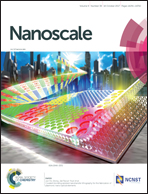Transparent amorphous strontium titanate resistive memories with transient photo-response†
Abstract
Transparent non-volatile memory devices are desirable for realizing visually-clear integrated systems for information storage. Optical transparency provides advantages in applications such as smart glass electronic devices and wearable electronics. However, achieving high transparency limits the choice of active layers as well as the electrodes; thereby, constraining device processing and performance. Here, we demonstrate bilayer transparent memory cells using room temperature deposited amorphous strontium titanate as the functional material and indium tin oxide electrodes. The entire device is fabricated on glass, making the system highly transparent (>85%) in the visible spectrum. The devices exhibit switching ratios of over two orders of magnitude with measured retention of 105 s and endurance 104 cycles. Through the cross-sectional microstructural analyses it is shown that the asymmetric interfaces and distribution of oxygen vacancies in the bilayer oxide stack are responsible for defining the bipolar resistive switching behaviors. A photoluminescence mapping technique is employed to map the evolution of oxygen vacancies and pinpoint the location of the conductive filament. A transient response to optical excitation (using UV and blue light) is demonstrated in the high resistance state which indicates their potential as multifunctional memories for future transparent electronics.



 Please wait while we load your content...
Please wait while we load your content...